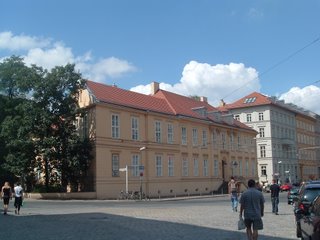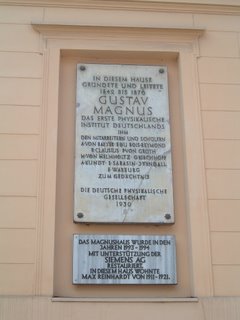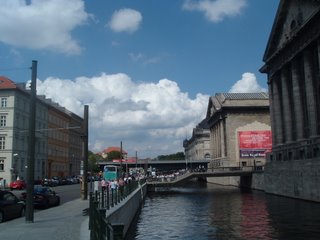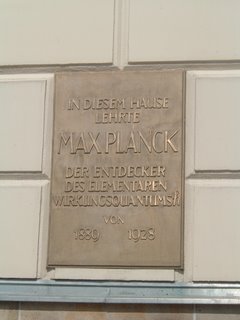The big physics institutes of today's Berlin are not located anymore in the city center - the institute of the Technical University is in Charlottenburg, that of the Free University in Dahlem in the south-west, and the institute of the Humboldt University, the old Berlin University, has moved outwards to Adlershof in the south-east. But Berlin Mitte accommodates several locations of historical importance for physics.
For example, it is the location of one of the first dedicated physics institutes in Germany. Remarkably, this institute did not belong to the Berlin University, but was privately owned by Gustav Magnus, who was the professor of physics at the University from 1845 to 1870. He may be known today mainly for the Magnus effect, which is relevant for all kinds of sports with balls. But besides doing research in chemistry and physics, he was also teacher of well-known physicists of the 19th century, for example of Clausius and Helmholtz. He offered practical laboratory work for his students in his house, and organized a weekly meeting which was to become the Berlin Physics Colloquium. His institute today is known as Magnus-Haus, and it is used by the German Physical Society.

There is a plate on the building to the memory of Magnus and his students and collaborators:

The lower plate states that theatre director and actor Max Reinhardt lived in the Magnus-Haus from 1911-1921, but it does not mention that it was also the home of Joseph-Louis Lagrange in the 1770s, when Lagrange was Director of Mathematics at the Berlin Academy of Sciences.
The address of the Magnus-Haus, Am Kupfergraben, may be better known today as the address of German chancellor Angela Merkel, a physicist who obtained her Ph.D. in quantum chemistry. It seems that she prefers an apartment in the charming yellow building at the right on the upper photo to one in the pharaonic Bundeskanzleramt. Besides the building, the neighborhood is much nicer also: Am Kupfergraben is just opposite of the Museumsinsel,

which is home to several museums of arts and antiques, among them the famous Pergamon-Museum:

The backyard of the Magnus-Haus nearly touches the backyard of the main building of the Humboldt University, the old Berlin University founded in 1810, and named today after the Humboldt brothers: Alexander, the scientist, and Wilhelm, the grand reformer of higher education in Prussia. The front of the University building goes to Unter den Linden, the main boulevard of Berlin between the Dom in the east and the Brandenburg Gate in the west. The courtyard of the University is observed by a grumpy looking Helmholtz:

I was about to turn back towards the direction of the Dom and to my meeting, when I spotted another bronze plate at the west wing of the University building.

It says that Max Planck was working here a the time when he discovered the law of black-body radiation and the quantum of action:

PS: The title of this post is shamelessly stolen form a regular piece in the journal Physics in Perspective, The Physical Tourist at Someplace. Berlin is the subject of the article in the December 1999 issue, from where I have obtained most information used here. The author of that piece, a science historian at the Max Planck Institute for the History of Science in Berlin, has also written a very interesting book about places connected to Einstein's life in Berlin - unfortunately, there is only a German edition so far.
Tags: Berlin, Physics, History of Science.

Dear Stefan,
ReplyDeletewhat a nice report from your trip! Coincidentally, I read today an article about the
Cafe Einstein
in Berlin (see also this georgeous Flickr Photo). Allegedly everybody, who is, was, or will ever be famous goes for lunch there.
But hey, here in the US we have the Einstein Bros!
Best,
B.
(my share about physical tourism in Santa Barbara)
Well, I've heard of people being dumbstruck, but I guess the beauty and Majesty of masonry & the New Berlin is just too awesome for words.
ReplyDeleteStefan thanks for this great historical post of Berlin's place in the his&her story of Physics, and its future capital role in the World of Physics.
It really really was (and is?) the breeding ground for modern nuclear, particle & theoretical physics
Bee, love the cafe Einstein pic from flickr - I might have to use that in one of my future posts
ReplyDeleteHi Quasar,
ReplyDeletethank you for your comments. Well, the New Berlin, that's mostly (this is my impression, but these parts are the the most visible ones) the area around Spreebogen and Brandenburger Gate, with the new buildings for the Bundestag (the parlament), the Bundeskanzleramt (the chancellors office), the new Hauptbahnhof (central station), and around Potsdamer Platz a little more south. These are areas where there has been lots of empty space right in the center of the City because of the Wall... But the scale of these new buildings is really gigantic. For example, the Swiss embassy, in an old, surviving City Palais, is completely dwarfed between the Hauptbahnhof and the Bundeskanzleramt.
About the role of modern-day Berlin for physics, well, I am not so sure... It definitely does not compare to the time a century ago...
Best, stefan
Stefan the architecture of New Berlin is second to none.
ReplyDeleteAnd at least the History of Physics is second to none.